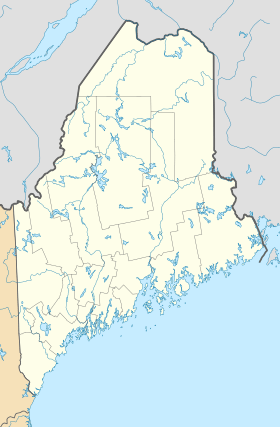Fort Baldwin facts for kids
Quick facts for kids Fort Baldwin |
|
|---|---|
| Part of Coast Defenses of the Kennebec | |
| Phippsburg, Maine | |
| Type | Fortification |
| Site information | |
| Owner | Public - State of Maine |
| Open to the public |
Yes |
|
Fort Baldwin Historic Site
|
|
 |
|
| Location | Sabino Hill, Phippsburg, Maine |
| Area | 6 acres (2.4 ha) |
| Built | 1905 |
| Architect | United States Army Corps of Engineers |
| NRHP reference No. | 79000166 |
| Added to NRHP | August 3, 1979 |
| Site history | |
| Built | 1905–1912 |
| Built by | U.S. Army Corps of Engineers |
| In use | 1912–1924, 1941–1945 |
| Materials | Reinforced concrete, earth |
| Garrison information | |
| Garrison |
|
Fort Baldwin is an old military fort near the Kennebec River in Phippsburg, Maine, United States. It was built to protect the coast. Today, it is a special place called the Fort Baldwin State Historic Site.
The fort was named after Jeduthan Baldwin. He was an engineer during the American Revolution. Construction on the fort began in 1905 and finished in 1912. It originally had three main gun areas, called batteries. In 1979, Fort Baldwin was added to the National Register of Historic Places. This means it is an important historical site.
Contents
What Were the Artillery Batteries?
Fort Baldwin had three main areas where large guns were placed. These were called batteries. Each battery was named after a brave soldier.
- Battery Cogan: This battery had two 3-inch guns. These guns were placed on special stands called pedestal mounts. It was named after a lieutenant from the American Revolution. He was a quartermaster and died in 1778.
- Battery Joseph Roswell Hawley: This battery held two 6-inch guns, also on pedestal mounts. It also had the fort's first observation post. This post helped soldiers see enemy ships. It also housed electric equipment. This battery was named after Brigadier General Joseph R. Hawley. He was a hero in the American Civil War.
- Battery Hardman: This battery had one 6-inch gun. This gun was on a "disappearing carriage." This meant the gun could be hidden after firing. It was named after a captain from the American Revolution. He was captured and died as a prisoner in 1780.
A Look Back: Fort Baldwin's History
Fort Baldwin played a role in protecting the coast during two major wars.
Early Years and World War I
Before American entry into World War I, Fort Baldwin was mostly empty. It was likely part of the Coast Defenses of the Kennebec. During World War I, about 200 soldiers lived at Fort Baldwin. They were from the 13th and 29th Coast Artillery companies.
In 1917, all three 6-inch guns were taken from the fort. They were planned to be used on the Western Front in France. However, the war ended before these guns saw much action. The guns from Battery Hawley were put back at the fort in 1919. The gun from Battery Hardman was sent to France and never returned to Fort Baldwin.
Between Wars and World War II
In 1924, Fort Baldwin's guns were removed. The fort was then sold to the State of Maine.
When World War II began, the fort became active again. Four round concrete platforms were built. These were called "Panama mounts." They were for larger 155 mm guns. These guns could be moved around.
From 1941 to 1943, soldiers from the 8th Coast Artillery Regiment protected Fort Baldwin. The fort had a special Fire Control Tower. This tower could tell other forts the exact location of enemy ships. This helped larger guns, like the 16-inch guns at Battery Steele, target enemies.
A group of four 155 mm guns was placed at Fort Baldwin from early 1942 to January 1944. After World War II, the Army gave the fort back to the State of Maine in 1949.



